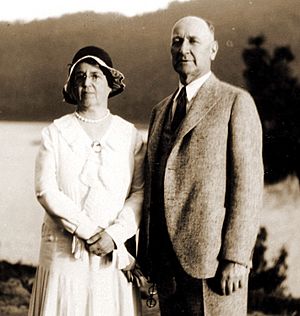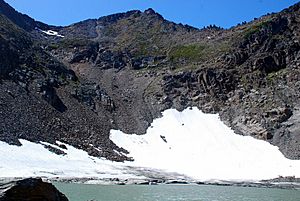Albert Hale Sylvester facts for kids
Quick facts for kids
Albert Hale Sylvester
|
|
|---|---|

Albert H. Sylvester and his wife Alice
|
|
| Born | May 25, 1871 San Mateo, California, United States
|
| Died | September 14, 1944 (aged 73) Wenatchee, Washington, United States
|
Albert Hale Sylvester (born May 25, 1871 – died September 14, 1944) was a pioneering surveyor, explorer, and forest supervisor. He worked in the amazing Cascade Range of Washington state. From 1897 to 1907, he was a mapmaker, also called a topographer, for the United States Geological Survey (USGS).
Later, from 1908 to 1931, he became the first forest supervisor of Wenatchee National Forest for the United States Forest Service. His job involved making the first detailed maps of large parts of the Cascade Mountains. During this work, he gave names to over 1,000 natural places. He often had to climb mountains to place markers for his surveys. He was also the first person to climb many mountains in Washington. He explored areas that non-native people had never seen before. One famous place he discovered and named is The Enchantments. In 1944, while leading friends on a trip, Sylvester was badly hurt when his horse fell on a steep slope. He later died from his injuries.
He once wrote that the most beautiful place he explored in the Cascades was the Buck Creek area. This spot is near Buck Creek Pass in northeast Chelan County.
Contents
Naming Mountains and Lakes
Albert H. Sylvester named more than 1,000 natural places in the Cascade Range. Some people even think he named as many as 3,000! These names include Enchantment Lakes, Dishpan Gap, Lake Margaret, Lake Ethel, Lake Mary, Lake Florence, Lake Flora, and Kodak Peak. He also named a group of peaks "Poets' Ridge" after famous writers like Irving, Poe, Longfellow, Bryant, and Whittier.
About the Enchantment Lakes area, which is now a very popular place for backpacking, he wrote: "it was an enchanting scene. I named the group Enchantment Lakes."
During his career, new maps were often made for the region where he worked. This helped his place names become well-known and used. He named so many places partly because of Gifford Pinchot, who was the first Chief of the Forest Service. Back then, national forests were new and often didn't have many maps or names for places. To protect the forests from wildfires, it was important to have names for natural features. This way, fires could be located easily, and firefighters could be sent to the right spots.
Sylvester found himself exploring and mapping a huge area with very few existing names. He was given the job of giving names to these places. He explained: I began place-naming more diligently... because in fire protection work it was very desirable, even imperative, that the natural features capable of being named should have names as an aid in locating fire and sending in crews to combat them.
Sylvester's names are found all over the central and northern Cascades in Washington. They are especially common in the Wenatchee Mountains, Entiat Mountains, Chelan Mountains, and the Glacier Peak area. In some river valleys, like the Chiwawa River and Entiat River, almost every stream and peak was named by Sylvester.
His naming was often very creative and sometimes funny. For example, he named Aurora Creek and Borealis Ridge. He also named three "baking powder creeks": Royal, Crescent, and Schilling Creeks, after popular brands of baking powder. The "American poets' peaks" include Bryant Peak (for William Cullen Bryant) and Poe Mountain (for Edgar Allan Poe).
He named Indian Pass and Indian Creek because of an old Native American trail. Near there, he named Kloochman Creek and Tillicum Creek. These are Chinook Jargon words for wife and friend. He thought "an Indian should have both a wife and a friend." Labyrinth Mountain got its name because its map lines looked like a maze. He then named Minotaur and Theseus Lakes on the mountain. He named Mount David and Mount Jonathan, which are close together. He named Mount Saul across the valley, like in the Bible story where Saul is near but separated from David and Jonathan.
Whimsical Names
Some of his most interesting names are quite unusual. Overcoat Peak was named because Sylvester left his overcoat there when he climbed it in 1897. He buttoned it around a survey marker. Dirtyface Peak got its name from discolored snow banks. Dishpan Gap was named after he found an old rusty dishpan there. Kodak Peak was named because his assistant lost a Kodak camera there. Pass-No-Pass was named because, as Sylvester said, "the pass has neither road nor trail."
Honoring People
Many of his names honor specific people. For example, Mount Fernow is named for Bernhard Fernow. Mount Maude is for Frederick Stanley Maude. Harding Mountain is for President Warren G. Harding. He named Klone Peak after his dog, Klone.
Naming Lakes for Women
Sylvester started a tradition of naming lakes after women. He named Lake Alice for his wife. Lake Margaret and Lake Mary were named for the sisters of a ranger. Lake Florence was for a friend of theirs. Lake Augusta was for his mother. Lake Ethel was for the wife of Ranger Frank Lenzie.
Other Notable Names
Sometimes, the reason for a name isn't obvious. Candy Creek was named for its sweet-tasting water. Cardinal Peak was not named for the bird. It was named because it was the "supremacy among adjacent mountains," meaning it was the highest peak. He named Crook Mountain for an Army officer named George Crook. Sylvester renamed it because there were too many "Goat Mountains" already. He didn't have a horse die on Deadhorse Pass. That name was already used by sheep herders. Grindstone Mountain was named because Sylvester found a small grindstone there. Lake Sally Ann was a name Sylvester simply "invented." Tinpan Mountain was named just because "it was just a name for a place needing naming."
Other famous places he named include Seven Fingered Jack, Fortress Mountain, Tumwater Canyon, Jove Peak, and Napeequa River.
Climbing Peaks
Albert H. Sylvester climbed many mountains in the Cascades. He often did this for his surveying work. Many of his climbs were the first time anyone had reached the top. In 1897 and 1898, he made several first ascents. These included Mount Baring, White Chuck Mountain, Columbia Peak, Overcoat Peak, and Sahale Peak. In 1898, he climbed Snoqualmie Mountain, Gardner Mountain, Star Peak, and Reynolds Peak. He climbed these mountains to set up markers for his maps.
His Final Journey
In September 1944, Sylvester went on a trip into the mountains with three friends. They had horses for riding and for carrying their gear. Their trip took them through beautiful areas like Chiwaukum Creek, Lake Chiwaukum, Larch Lake, Ewing Basin, and Cup Lake. From Cup Lake, the trail became very rough and steep. They continued over Deadhorse Pass.
While they were resting between Lake Mary and Lake Florence, Sylvester's horse got scared. It ran off the trail and bucked. One of the ropes from a pack horse got caught on Sylvester's leg. This held him in the saddle as both horses fell down a steep, rocky slope. Sylvester was seriously injured in the accident. Rescuers carried him out of the mountains. He was taken to a hospital in Wenatchee. Sadly, he died from his injuries within a week.
His Lasting Impact
Besides the many places Sylvester named, some places are named after him. After he died, friends asked for Snowgrass Mountain to be renamed for him, but this was not allowed. Instead, Sylvester Lake, which is southwest of the mountain, was named in his honor. This lake is near Alice Lake, which Sylvester had named for his wife. A creek on the upper Green River in King County was also renamed Sylvester Creek to honor him.


